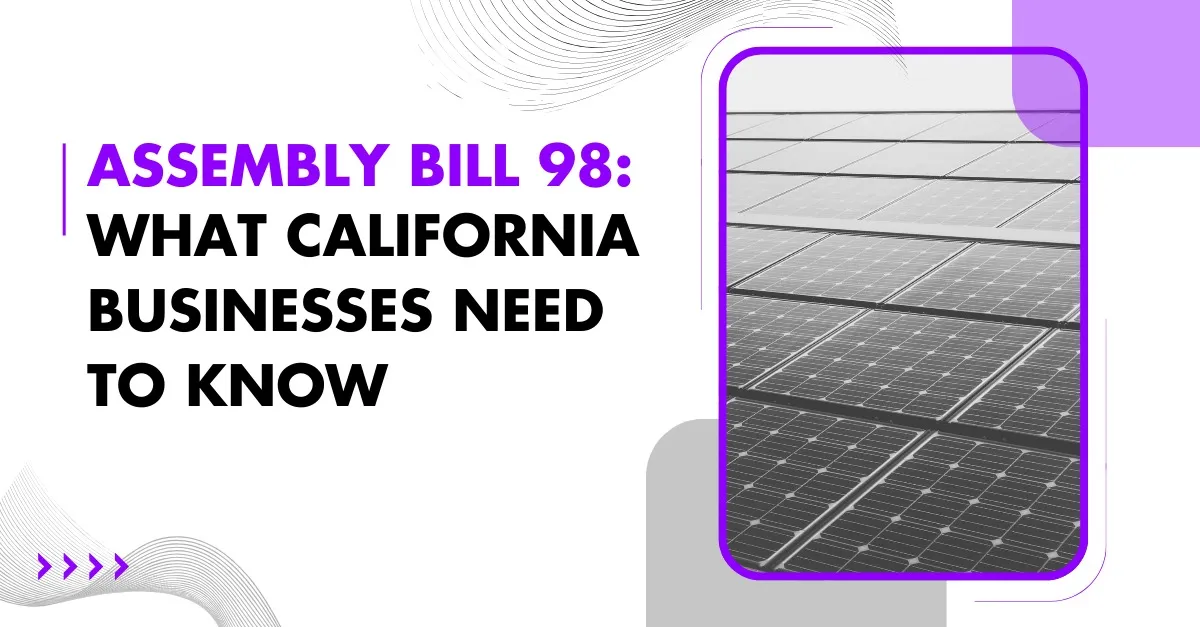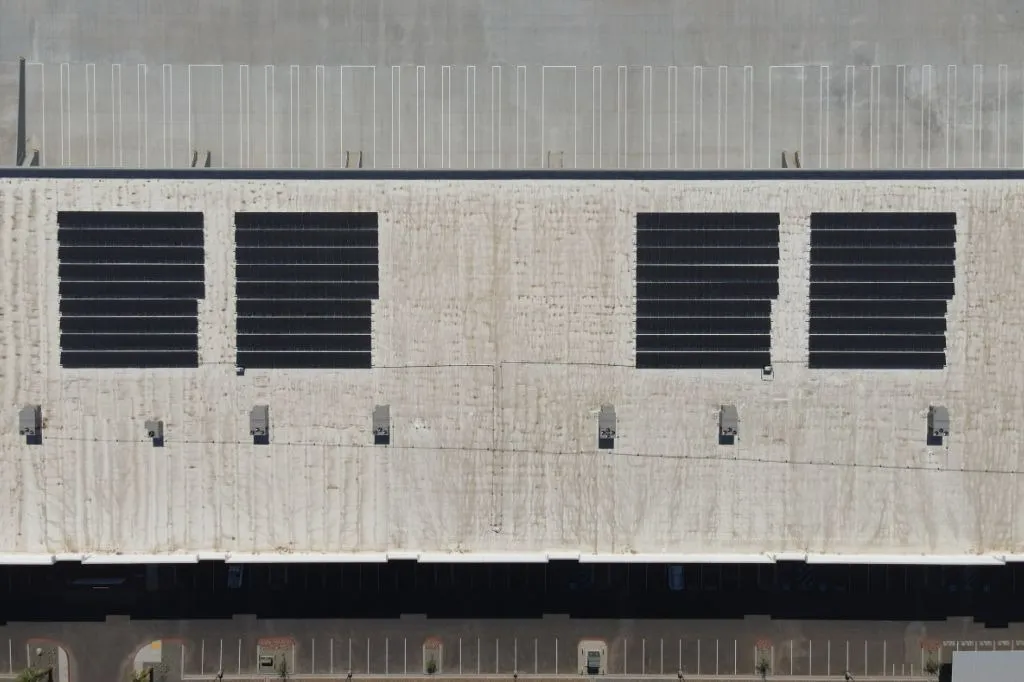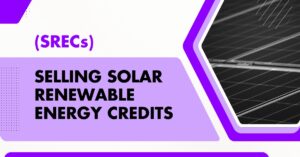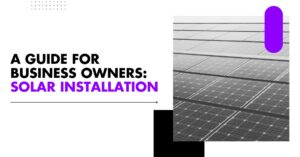AB 98 Unpacked: What California Businesses Need to Know

AB 98 Unpacked: What California Businesses Need to Know
If you’re a business owner in California, it’s time to put Assembly Bill 98 (AB 98) on your radar.
A new piece of legislation passed in September of 2024, this bill has some significant implications for industries like warehousing, logistics, and transportation.
The state has long been a forerunner in its sustainability efforts, and AB 98 is its latest move to make sure businesses all around the Golden State are contributing equally to a brighter, greener future.
AB 98 introduces stricter design and operational standards to make warehouses and similar facilities more energy-efficient and environmentally friendly.
In this post, we’ll break down the legalese and tell you what kinds of implications this bill could have on the way you do business now as well as long in the future.
What is AB 98?
Simply put, Assembly Bill 98 sets new standards for how warehouses and logistics facilities should be built and operated in the state of California. It has the ultimate goal of addressing the environmental impact of those facilities as well as the equipment that keeps them running.
Here are the main points of focus:
- State-Mandated Design and Build Standards: The bill outlines how new warehouses should be constructed with sustainability in mind. Think solar panels, energy storage solutions, and EV charging infrastructure.
- Energy Efficiency Requirements: AB 98 mandates that these facilities meet certain energy benchmarks to reduce their carbon footprint.
- Truck Route Updates: Logistics relies heavily on trucks, but AB 98 requires updated plans to avoid routes that cut through residential neighborhoods or sensitive areas like schools and hospitals.
The timeline for these changes is shorter than you might think. General requirements will kick in on January 1, 2026, meaning there’s less than a year to get ready. For truck routes and circulation updates, you’ll have until January 1, 2028 to make any necessary changes.
Key Changes Businesses Need to Know

Trying to sift through the murky language of AB 98 can be tricky, so we’ll break down some key changes you need to pay close attention to as the implementation deadline approaches:
New Building Standards for Warehouses and Logistics Facilities
First up, your warehouse may need a makeover—especially if it’s considered a “Tier 1” facility. These are warehousing facilities larger than 250,000 square feet, and they’re set to face stricter requirements than their smaller counterparts.
You should also expect to see regulations mandating solar panels on roofs, battery storage setups, and robust EV charging systems. These changes, again, have the goal of reducing emissions and energy usage across the board, making each facility part of the state’s sustainable agenda.
If this feels overwhelming, don’t stress. At IE Construction, we can help with retrofitting existing structures to meet these new obligations or even with designing brand-new facilities that check every box.
Truck Routing and Circulation
If you are involved at all in a truck-heavy industry, know that AB 98 wants to keep heavy-duty vehicles away from residential neighborhoods, schools, and other sensitive zones. Businesses will need to work closely with city planning agencies to create updated truck routes—and that might require some big adjustments.
But there’s a silver lining here, and another reason to adjust your plans besides just staying in line with AB 98. Improved truck routes will help you comply with the law, but you may also find that they streamline logistics efficiency.
After all, better routes mean fewer headaches for delivery timelines and smoother operations overall.
The Transition to Zero-Emission Equipment
2030 is the deadline for transitioning certain equipment, like forklifts, to zero-emissions models. The legislation takes a hard stance on replacing outdated machinery with cleaner alternatives.
Again, while the up-front costs may cause some initial sticker shock, zero-emission forklifts and equipment can help businesses save significantly on maintenance and fuel over time. Plus, there are often grants or subsidies available to help offset these costs.
Buffer Zones and Community Safeguards
AB 98 also introduces measures to balance business operations with community well-being. For warehouses near sensitive areas like homes or hospitals, buffer zones are now a necessity. As a business owner, this might mean adding landscaping barriers or soundproofing measures to reduce the impact on nearby communities.
Also, plan to say goodbye to unlimited diesel idling. Trucks will need plug-in solutions to prevent idling and reduce harmful air pollution. For those operating in high-density warehouse hubs like Riverside and San Bernardino, expect these restrictions to be enforced even more.
How Can Businesses Prepare?

The financial implications of AB 98 may be significant for businesses, as structural changes like solar panel integration, energy-saving upgrades, and facility redesigns are likely to increase upfront costs.
But the silver lining here is long-term savings. Installing energy-efficient systems can significantly reduce utility costs over time while positioning your business to meet future environmental regulations without any last-minute scrambles.
Non-compliance with these regulations is risky, especially considering fines could go as high as $50,000 for every six months. There’s no reason to balk at the new requirements. In addition to the potential for long-term savings, fully compliant businesses may find themselves enjoying better community relations thanks to improved health and environmental impacts.
You know the benefits of compliance, and you know the risks of ignoring the regulations. The big question is, where do you start?
First, conduct a thorough evaluation of your current facilities. Identify areas that might fall short of AB 98’s requirements and get an action plan in place. This could include upgrading aging HVAC systems, installing solar power, or even retrofitting old buildings to meet efficiency standards.
Next, prioritize your business’ compliance with zero-emission equipment regulations. This may mean transitioning forklifts, trucks, and even smaller machinery to electric or other zero-emission alternatives. And don’t wait—transforming operations like truck routing or acquiring permits for new upgrades could take more time than you anticipate.
Finally, think about who can help. Sustainability consultants and experienced construction firms like our team at IE Construction can be your best allies. By teaming up, you can make the process smoother and lessen the headache when it comes to meeting state requirements.
Benefits and Impacts of AB 98
While adjusting for AB 98 might feel like a hassle at first, its benefits can’t be ignored. For starters, it’s a win for the environment. By adopting renewable energy and zero-emission technology, businesses will help reduce pollution and promote better air quality across California.
These changes also provide a chance to build stronger relationships with local communities.
Showing that your company cares about sustainability isn’t just good PR—it’s a way to gain trust and support locally. Customers and neighbors tend to notice when a business is working to make their community healthier.
Ready to future-proof your business and stay in line with the latest regulations under AB 98? By taking the steps now to meet the bill’s requirements, you’ll not only avoid fines and delays but also improve efficiency and make a lasting positive impact.
Need help getting started? IE Construction can guide you through the process. Whether it’s switching to energy-efficient systems, managing zoning challenges, or moving toward zero-emission compliance, our team specializes in turning AB 98 requirements into opportunities for your business.
Don’t risk falling behind. Get in touch with IE Construction today to start your path to compliance while supporting your business goals. Together we can build a greener, more efficient future!




